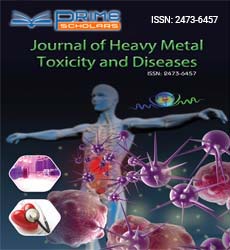Commentary - (2024) Volume 9, Issue 5
The Crucial Role of Healthcare Providers in Recognizing and Managing Heavy Metal Toxicity
Paul Jones*
Department of Healthcare, Mainz University, Germany
*Correspondence:
Paul Jones,
Department of Healthcare, Mainz University,
Germany,
Email:
Received: 01-Oct-2024, Manuscript No. ipjhmct-24-21862;
Editor assigned: 03-Oct-2024, Pre QC No. ipjhmct-24-21862 (PQ);
Reviewed: 17-Oct-2024, QC No. ipjhmct-24-21862;
Revised: 22-Oct-2024, Manuscript No. ipjhmct-24-21862 (R);
Published:
29-Oct-2024, DOI: 10.21767/2473-6457.24.5.49
Description
Heavy metal toxicity is a significant public health concern,
with potential health effects ranging from acute poisoning
to chronic conditions, including neurological disorders, renal
damage, and developmental issues in children. As frontline
responders, healthcare providers play a vital role in identifying
and managing heavy metal exposure in their patients. However,
effective recognition and treatment require specialized training
and awareness. This article explores the importance of training
healthcare providers in recognizing and managing heavy metal
toxicity, the key components of such training, and its impact
on patient outcomes. Heavy metals, including lead, mercury,
arsenic and cadmium, can enter the body through various
routes, such as ingestion, inhalation, and dermal contact.
Symptoms of heavy metal toxicity can be nonspecific and may
mimic other health conditions, making diagnosis challenging.
For instance, lead poisoning may present with abdominal pain,
fatigue, and cognitive deficits, while mercury exposure can lead
to neurological symptoms, including tremors and memory loss.
Early identification of heavy metal exposure is crucial for effective
intervention. Training programs can help providers recognize the
signs and symptoms of toxicity, as well as understand risk factors
associated with different populations, such as children and
pregnant women. Healthcare providers must be familiar with
diagnostic tools and laboratory tests used to assess heavy metal
levels in patients. Training can enhance their ability to interpret
test results and differentiate between normal and elevated levels
of metals. Treatment of heavy metal toxicity may involve various
approaches, including chelation therapy, supportive care, and
lifestyle modifications. Training programs can educate providers
on the appropriate use of specific treatments, potential side
effects, and follow-up care. Trained healthcare providers can
serve as advocates for public health initiatives aimed at reducing
heavy metal exposure in communities. They can educate patients
about prevention strategies and promote policies that address
environmental hazards. Heavy metal toxicity often requires
a multidisciplinary approach involving various healthcare
professionals, including physicians, nurses, environmental health
specialists, and toxicologists. Training can foster collaboration
and improve communication among team members. Training
should provide comprehensive information about common
heavy metals, their sources, health effects, and routes of
exposure. This knowledge forms the foundation for recognizing
potential cases of toxicity. Providers should learn to identify the
clinical manifestations of heavy metal exposure and understand
the risk factors associated with specific populations. Training
should cover the appropriate diagnostic tests for detecting heavy
metals in the body, including blood and urine tests. Providers
should be informed about normal ranges, interpretation of
results, and when to refer patients for specialized testing.
Educating providers about evidence-based treatment protocols
for heavy metal toxicity is essential. This includes the use of
chelation agents, indications for treatment, and monitoring for
potential side effects. Training should emphasize the importance
of prevention and education, equipping providers with the tools
to counsel patients on reducing exposure to heavy metals in their
environments. Trained providers can raise awareness in their
communities about the risks associated with heavy metals, leading
to better preventive measures and public health initiatives. Early
detection and management of heavy metal toxicity can prevent
chronic health issues, ultimately reducing healthcare costs and
improving population health. Training healthcare providers in
recognizing and managing heavy metal toxicity is essential for
improving patient outcomes and promoting public health.
Acknowledgement
None.
Conflict Of Interest
The author states there is no conflict of interest.
Citation: Jones P (2024) The Crucial Role of Healthcare Providers in Recognizing and Managing Heavy Metal Toxicity. J Heavy Met Toxicity Dis. 09:49.
Copyright: © 2024 Jones P. This is an open-access article distributed under the terms of the Creative Commons Attribution License, which permits unrestricted use, distribution, and reproduction in any medium, provided the original author and source are credited.

